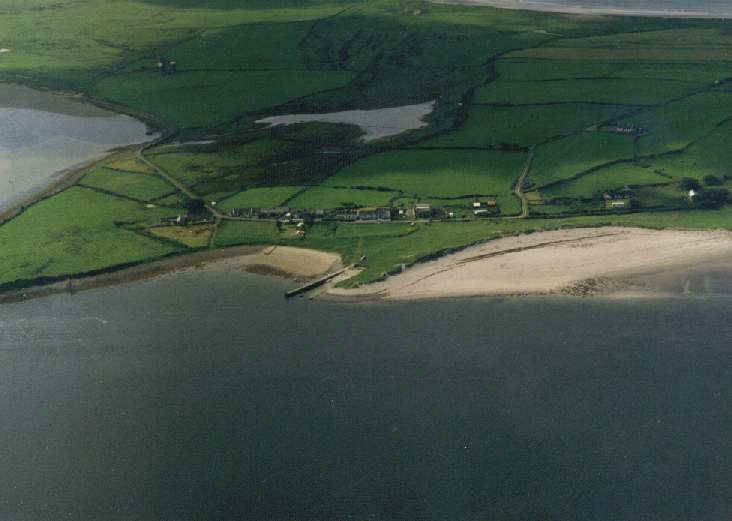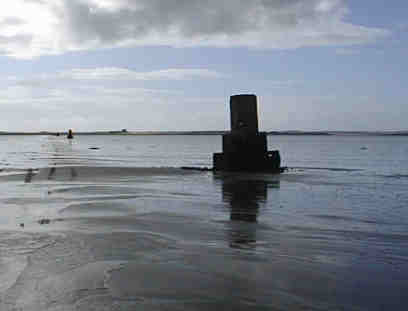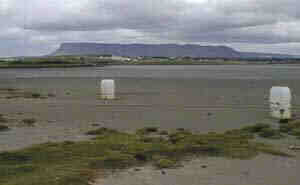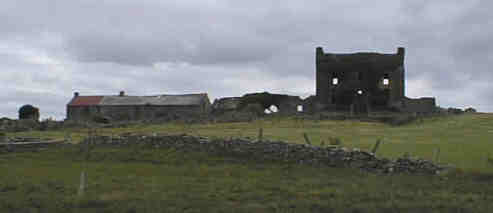
By Brian Leyden
In the first brittle days of marriage, days of tender feelings and panic, days of
gladness and uncertainty, I go walking by myself out to Coney Island.
What am I looking for? An act of passage? A place to gather my thoughts and the special colours of the day? Or a straightforward outing across the sandflats that connect this island breakwater at the mouth of Sligo harbour to the mainland near Strandhill? I have one clear purpose. To find St. Patrick's wishing chair, an 'erratic' boulder deposited on the north-west corner of Coney Island: or if you prefer, a Druid Stone embossed with Patrick's handprint.
Sligo was an early haunt of the Saint and the locality overflows with holy wells, sacred stones and stories of Patrick's miraculous showdowns with an older religion.
Along the coast today I see modern bungalows, conifer plantations and a small airport, beyond which a baritone sea breaks on the headland of Killaspugbrone. The place name translates as the Church of Bishop Brone. A ruined church and graveyard survive. The Saint is said to have lost a tooth there, which he gave to his disciple, Brone. Displayed amongst the Christian artifacts in the National Museum, in Dublin, is the Fiancail Padraig: Patrick's tooth. A gold reliquary with shamrock filigree, rough jewels, an inlay of episodes from the life of the Saint, and a crucified Christ with his ribs sticking out. In the centre is a clouded aqueous eye that conceals the tooth.
The label says, '12th to 14th Century AD', and assigns the relic to Athenry. No mention of Sligo. But the Patrick story is riddled with these shifts in time and location. And the pleasure comes, not from following the footsteps of the Saint, with a leaky cargo of folklore and local history; it has more to do with that life-centering tingle I feel whenever I approach an island.
 I had
hoped for a fine day. For dramatic changes of light on the surrounding mountains of Ben
Bulben, Slieve Daeane and the Lady's Bray. Place names weighted in legends older than
Patrick. But Queen Maeve's tomb on the crown of Knocknarea is out of sight, the limestone
mountain is a sullen presence. A platinum band of light divides the sea and sky.
I had
hoped for a fine day. For dramatic changes of light on the surrounding mountains of Ben
Bulben, Slieve Daeane and the Lady's Bray. Place names weighted in legends older than
Patrick. But Queen Maeve's tomb on the crown of Knocknarea is out of sight, the limestone
mountain is a sullen presence. A platinum band of light divides the sea and sky.
An avenue of fourteen stone pillars spans the straight, safe path to Coney Island, but they are sunk in a salt-water tide. Before the pillars were built locals say as many as twenty-eight people were drowned making this crossing.
"You can make the crossing umpteen times and still get caught", cautioned a woman who spends her summers on Coney.
North of the Island is Shrunamile, the channel of a thousand currents. It runs between Coney and the smaller Oyster Island. Next is the Metal Man on Perch Rock, who points to the deep water of the shipping channel off Rosses Point.
 With a
sea breeze behind it, an incoming tide can cover the sandflats of the south shore in
minutes. The sea closes around the island.
With a
sea breeze behind it, an incoming tide can cover the sandflats of the south shore in
minutes. The sea closes around the island.
"You have danger on both sides. You have to make people aware of the hazards. Otherwise you're walking them into trouble."
It is this daily ebb and rise of the tide that keeps an island bridged by land, and only five miles outside Sligo Town, so isolated and unvisited.
Things might have been different if Saint Patrick had finished his causeway. All that remains of this enterprise is Dunan Phadraig - Patrick's little fort - an outcrop of rock and marram grass between Coney and Killaspugbrone.
The story goes that hunger struck the good man while he worked, and he asked the principal family on the island, the Mulclohys -or Stoners- for food. The woman of the house had nothing to give Patrick. But when dinner time arrived she gave him a plate of stew. Patrick raised his hand to bless the food. There was movement on his plate and a cat jumped off the table. The woman confessed to serving cat stew in place of rabbit. Patrick was so outraged he said there would never be four sons born to any generation of the Mulclohy family- never enough pallbearers to carry a relation to the grave. Under this curse the Mulclohys died out, and the island, which had been known until then as Inishmulclohy became Coney Island- Rabbit Island.
The water is soon speckled with the coiled tubes of sand sprouted by countless
lugworms. Hummocks of seaweed appear and the 'gut' empties. Sea birds sentry the
retreating water-margin. Curlew calls and a flight of sandpipers lead the march onwards to
Coney Island.
The island is low and treeless. A single defiant two-storey ruin stands against the skyline. The Flood Mansion. Abandoned in 1928 when the family went to America. Wild ivy holds what's left of the roof in place through the worst storms.
A flock of gulls descends on inland pasture. After the sea the smell of the cows. Old breeds of cattle, mottled red and white, descendants, perhaps, of the animals that were walked off the island at night- when they would not be unsettled by the site of the water in the channel- to arrive at first light for the fair days in Collooney, Ballisodare and Manorhamilton.
Past Ward's Bar is a line of empty summer houses. A gas lamp post is a reminder that the island has water on tap but no electricity.
'There was a hundred people living on Coney one time. Cartys, Harans, McGowans, Wards, " Those were the names", says John McGowan, the island's only full time resident for many years. "Life was tough, but it was what you were brought up to. On a good day you went fishing. On a bad day you stayed in. A couple of pounds carried you over. You have more now, but against that you have the pressure."
Before going to Patrick's chair I stop at Cartystown- two houses. Then Carty's Strand. The sea here has a regenerative smell. A medicinal salt aroma. There is the full spume and splash of the open Atlantic. The next parish is America, 3,000 miles away, and another Coney Island, named after this one by a homesick sailor from Sligo, said to be on a merchant ship called the Arethusa. Seabirds skim the breakers, following their reflections.
The day is mild, incredibly calm, but the sea roars. Even in the sheltered coves there is a big valve radio hiss of sand and foam. Then gunshots. A heavy bombardment. The cannon peel and crack of surf behind the rise.
"Some families lived off nothing only the shore. They fished and gathered winkles, cockles, mussels, carrigeen moss and dillisk. During the war as soon as daylight came they were searching for logs of timber, boxes of butter and bales of rubber. You were supposed to surrender what you found to the Customs and Excise, but you could get £5 for a bale of rubber."
Those families are gone. Tradition allowed the island men to marry only women from the mainland. Most never returned. The girls just grew up and left. The island schoolhouse closed in 1940. There was a drowning tragedy in the fifties.
"Practically every day after that there was someone dropping out".
I double back along a green track past the fields of Seanbhaile - Oldtown, in the most prehistoric sense. And there it is. A boulder in the soggy ground made magical by legend. Saint Patrick's wishing chair. A seat, a footrest, a crude handprint and a cradle for one elbow. Its high back is upholstered with moss and lichen.
The sea plunges in thundering folds that seem to travel deep under the island. The vibrations magnified out of all proportion to the size of the waves. Their echoes roll and boom back out across the open channel. A guardian lighthouse on the Black Rock looks over my shoulder.
Seated in the stone chair I think of' those resolute men who serviced the original beacons, on the Black Rock and on the island. Carbide lights that left a residue of burnt lime the Coney people used to whitewash their homes. I recall the tradition of the hamper filled once a month with flour, condensed milk, syrup and corned beef, to feed the Principal and his Assistant Keepers, who manned the more remote lights. And how the condensed milk and the syrup were used to make presents of toffee, sent back in the empty corned beef tins. Along with the toffee for the children came a gift as intimate and heartfelt as a bottle full of coloured seashells, gathered by the light keeper for his wife on the mainland.
It has been said that one wish only will be granted each year to whoever sits in Patrick's chair.
But what more could I wish for? On the brink of the sea and so in love. As close now as I will ever be to the big eternals.